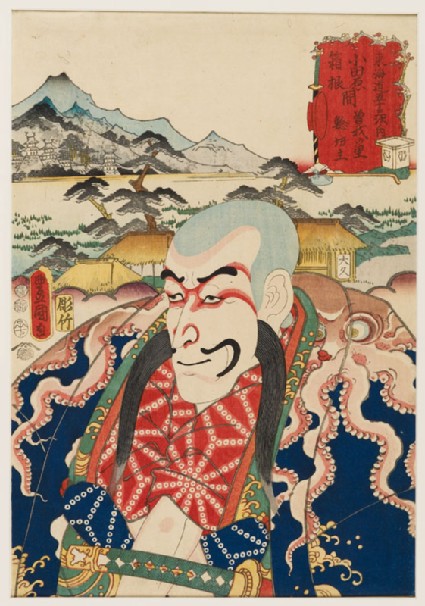Yakusha-e: Kabuki Prints, a Continuing Tradition
(from 29th Nov 2011 until 4th Mar 2012)Discover the brightly coloured woodblock prints of actors from Japanese popular theatre.

- Reference URL
Actions
The character Nyūdō Shinsai at Soga village, between Odawara and Hakone
-
Description
The Shibaraku scene is one of the most popular pieces in the kabuki repertoire. A scene of around fifty minutes, Shibaraku is not a complete play, but a short drama inserted between full plays to provide variety.
The plot centres around a warrior hero who intervenes just as an evil villain is about to kill some innocent people. The ‘Catfish Priest’ (so named for his long sideburns that resemble a catfish's whiskers) is one of the villain’s henchmen, who tries to persuade the hero to leave.
-
Details
- Series
- Stop a Moment!
- Associated place
-
Tōkyō (place of creation)Tōkyō (place of publication)Tōkaidō road (Soga village) (subject)Kanagawa prefecture (Odawara castle) (subject)
- Date
- 1852
- Artist/maker
-
Utagawa Kunisada (1823-1880) (designer)Yokogawa Takejirō (active c. 1852) (block cutter)
- Associated people
-
Tsutaya Kichizō (active c. 1830 - 1880) (publisher)Muramatsu Genroku (active c. 1843 - c. 1852) (censor)Fukushima Giemon (active c. 1849 - 1853) (censor)
- Material and technique
- Nishiki-e, woodblock print with ink and colour
- Dimensions
-
mount 55.5 x 40.2 cm (height x width)
sheet 35.2 x 24.4 cm (height x width)
- Material index
- Technique index
- Object type index
- No. of items
- 1
- Credit line
- Presented by Christ Church College, University of Oxford, 1983.
- Accession no.
- EA1983.65
Past Exhibition
see (1)Location
-
- currently in research collection
Objects are sometimes moved to a different location. Our object location data is usually updated on a monthly basis. Contact the Jameel Study Centre if you are planning to visit the museum to see a particular object on display, or would like to arrange an appointment to see an object in our reserve collections.
Notice
Objects from past exhibitions may have now returned to our stores or a lender. Click into an individual object record to confirm whether or not an object is currently on display. Our object location data is usually updated on a monthly basis, so please contact the Jameel Study Centre if you are planning to visit the museum to see a particular Eastern Art object.
© 2013 University of Oxford - Ashmolean Museum


